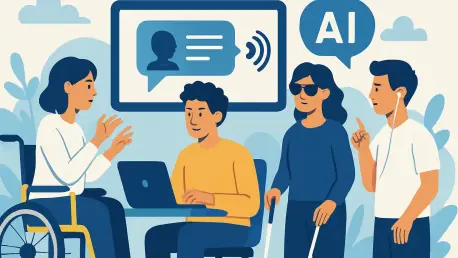In a world where digital technology often prioritizes dominant languages, the preservation and integration of minority languages like Welsh into modern platforms represent a profound challenge and opportunity. A groundbreaking project, spearheaded by University College London in partnership with Bangor University and NVIDIA, has harnessed the power of artificial intelligence to bring the Welsh language into the digital age. Utilizing the UK’s most advanced supercomputer, Isambard-AI in Bristol, this initiative under the UK-LLM program has crafted a sophisticated AI model tailored specifically for Welsh. This model stands out as the first to showcase robust reasoning abilities in the language, marking a significant milestone in accessibility. The implications of this development extend far beyond mere translation, promising to transform how public services and daily interactions are conducted in Wales. It sets a compelling stage for exploring how technology can bridge linguistic divides and enhance cultural inclusion in an increasingly digital society.
Breaking Digital Barriers for Welsh Speakers
The core mission of this AI initiative is to enhance access to essential public services in Wales, such as healthcare, education, and legal support, by enabling seamless bilingual interactions. This technology is designed to assist a diverse array of organizations, from hospitals and schools to retail outlets and media companies, in delivering services in both Welsh and English. By breaking down language barriers, the AI model ensures that Welsh speakers can engage with critical systems without facing linguistic exclusion. Moreover, this aligns closely with the Welsh Government’s Cymraeg 2050 strategy, which seeks to significantly boost the number of Welsh speakers over the coming decades. The potential to integrate this technology into everyday digital tools offers a lifeline to a language that has historically struggled for visibility in tech spaces, ensuring that cultural heritage is not lost amid rapid digital transformation. This development represents a vital step toward inclusivity, allowing communities to maintain their linguistic identity while participating fully in modern society.
Beyond public services, the AI model holds immense promise for education and language learning, creating new pathways for both native speakers and learners to engage with Welsh. By expanding access to learning resources, the technology can serve as a virtual tutor, helping users refine their skills and grasp the language’s unique intricacies. This is particularly impactful for second-language learners who often face limited opportunities to practice Welsh in real-world contexts. The model’s ability to adapt to individual learning needs means that it can provide personalized feedback, making language acquisition more accessible and engaging. Additionally, businesses and content creators can leverage this tool to produce Welsh-language materials, further enriching the digital ecosystem. The ripple effect of such advancements ensures that Welsh remains a living, evolving language, relevant not just in traditional settings but also in contemporary digital environments where younger generations increasingly reside.
Tackling Linguistic Nuances with Precision
One of the most formidable challenges in developing this AI model has been capturing the intricate nuances of the Welsh language, which poses unique difficulties for machine learning systems. Under the guidance of Gruffudd Prys from Bangor University’s Welsh language technology center, the team has dedicated significant effort to ensuring linguistic accuracy. With over two decades of expertise, Prys and his colleagues meticulously verify machine-translated training data and hand-translated evaluation sets to refine the AI’s performance. A particular focus lies on handling complex features like consonant mutations, which are integral to Welsh grammar but often trip up conventional AI systems. This precision is crucial for creating a tool that not only translates but also understands context and cultural subtleties, ensuring authentic communication. Such attention to detail underscores the transformative potential of AI in supporting minority languages, making technology a true ally in cultural preservation.
The impact of this meticulous approach extends into practical applications, ensuring that the AI can be trusted in high-stakes environments like legal and medical translations. Errors in these fields could have serious consequences, so the emphasis on accuracy is non-negotiable. The project’s commitment to quality sets a high standard for AI development in lesser-resourced languages, proving that with the right expertise, technology can adapt to even the most challenging linguistic landscapes. Furthermore, this focus on precision enhances user confidence, encouraging wider adoption across various sectors in Wales. As the AI continues to learn and improve, it promises to become an indispensable tool for maintaining the vibrancy of Welsh in modern contexts. This endeavor not only addresses immediate accessibility needs but also paves the way for long-term linguistic sustainability, ensuring that future generations inherit a language that thrives alongside cutting-edge innovation.
Setting a Global Precedent for Minority Languages
While the immediate focus of this project has been on Welsh, its implications reach far beyond the borders of Wales, offering a blueprint for other minority languages across the UK and globally. Plans are in motion to adapt similar AI models for languages such as Irish, Scottish Gaelic, Cornish, and Scots, fostering digital inclusion for diverse linguistic communities. International collaborations are also on the horizon, with ambitions to apply these techniques to underrepresented languages in regions like Africa and Asia. The Welsh model, along with its training data, will be made publicly accessible, empowering developers, public services, and businesses to tailor it for varied applications. Professor Pontus Stenetorp from University College London has noted the swift progress achieved through this collaboration, emphasizing the goal of using insights gained from Welsh to benefit other languages. This initiative highlights how localized solutions can inspire global change, ensuring technology serves as a tool for equity.
The broader vision of this project reflects a growing trend in leveraging AI to preserve linguistic diversity while enhancing digital inclusion for minority language speakers. Collaborators share a unified commitment to making technology relevant and accessible to smaller language communities, ensuring these tongues remain vibrant in a digitizing world. By addressing the unique needs of Welsh speakers, the project sets a powerful example of how innovation can intersect with cultural preservation. This approach challenges the tech industry to rethink accessibility, prioritizing inclusivity over uniformity. As more languages gain digital representation through such efforts, the narrative of technology as a cultural equalizer gains strength, promising a future where no language is left behind in the rush toward modernization. This global perspective amplifies the significance of the Welsh AI model, positioning it as a catalyst for widespread linguistic empowerment.
Pioneering a Path for Cultural Inclusion
Reflecting on the strides made, this AI breakthrough for Welsh marks a pivotal moment in integrating minority languages into digital frameworks, reshaping how accessibility is perceived. The collaboration between academic institutions and tech leaders demonstrates what is possible when innovation meets cultural commitment, delivering tangible benefits to Welsh-speaking communities. Looking ahead, the next steps involve scaling this technology to further refine its capabilities, ensuring it meets evolving needs. Stakeholders are encouraged to explore partnerships that can expand the model’s reach, integrating it into more platforms and services. Additionally, continuous feedback from users will be vital to address any gaps and enhance functionality. The success of this initiative serves as an invitation to tech developers worldwide to prioritize linguistic diversity, proving that technology can be a powerful force for inclusion. By building on these foundations, the future holds promise for a digital landscape where every language finds its voice.









